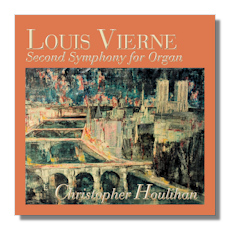
The Internet's Premier Classical Music Source
Related Links
-
Vierne Reviews
Widor Reviews - Latest Reviews
- More Reviews
-
By Composer
-
Collections
DVD & Blu-ray
Books
Concert Reviews
Articles/Interviews
Software
Audio
Search Amazon
Recommended Links
Site News
 CD Review
CD Review
French Organ Symphonies

- Louis Vierne:
- Symphony #2 in E minor, Op. 20
- Carillion de Westminster from Fantasy Pieces, Op. 54 #6
- Charles-Marie Widor:
- Allegro from Symphony #6 in G minor, Op. 42 #2
- Andante sostenuto from Gothic Symphony in C minor, Op. 70
Christopher Houlihan, organ
Austin Organ, Op. 2736 (1971)
Trinity College Chapel, Hartford, Connecticut
Towerhill Recordings TH-72018 2007 63:01
Louis Vierne (1870-1937) studied with César Franck and Charles-Marie Widor (1844-1937) and among his own students were Marcel Dupré and Nadia Boulanger, for whom Aaron Copland wrote his Symphony for Organ and Orchestra. These "symphonies" by Vierne and Widor are for organ alone. It is not easy to compare them with orchestral symphonies. They do have multiple movements – five each in the case of both Vierne's 2nd and Widor's 6th but, as here, individual movements are frequently played by themselves in recitals or on recordings, even by such organists as E. Power Biggs, Virgil Fox and Michael Murray. I was first introduced to works of the modern French organ school in an exciting recital many years ago by Lavahn Maesch at the Lawrence University Conservatory of Music, of which he was director, and his program included several movements from different organ symphonies. Organ music tends to be associated with churches but these are strictly secular, absolute music. Even secular music is often recorded in churches, because the great organs tend to be in such venues.
The movements in Vierne's Second Symphony are marked Allegro, Choral, Scherzo, Cantabile and Final, providing considerable change of pace and character over the nearly forty minutes duration. The dynamics range from very loud to very soft and a strong merit of this performance and recording is that the different voices can be distinguished clearly, even when one is softer than another played at the same time.
The sound is clean. In a review of another recording of this work, coupled with Vierne's First Symphony, John E. Roos (Fanfare, reproduced by Arkivmusic.com) delights in the acoustics of Saint Sulpice in Paris, and the "impact of these thunderous sounds echoing through the cathedral's expanse, rattling the windows, shaking the walls." I experienced similar sublime shock and awe in New York City's Riverside Church once, but I wonder if such thrills are really musical. The Trinity College Chapel does not shake here. The program note of an old recording on Classic Editions of Dupré's Symphonie Passion, Op. 23, calls the Trinity College Chapel "an ideal setting for the [organ]; lofty and resonant, it provides the acoustic necessary for the full development of organ tone." At the time of this old recording the organ there, "a great instrument" by Harrison and Noble, with 65 stops and 4,323 pipes had been installed in 1932. Evidently this organ was replaced by a presumably even better one in 1971. The specs for this are listed in the Towerhill notes.
Christopher Houlihan was a brilliant undergraduate student at Trinity College at the time of this recording and had already been distinguished by more than one honor. Since then he has studied and worked in France and is presently, I believe, at Julliard. There are some YouTube clips of and about him. Regarding his live performance of this Second Symphony by Vierne, Brian Jones of the American Guild of Organists gave Houlihan a rave review in Boston Chapter's Newsletter (Sept. 1, 2007 issue.)
As far as the Widor 6th Symphony movement is concerned, I know is a recording by David Patrick which is nearly two minutes faster but I think the big sound of this piece may benefit in clarity from Houlihan's tempo. Houlihan's Gothic Symphony and Fantasy Pieces excerpts are lovely. Available from Towerhill Recordings.
Copyright © 2009, R. James Tobin


















